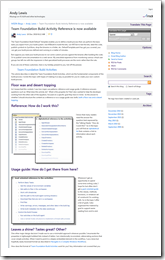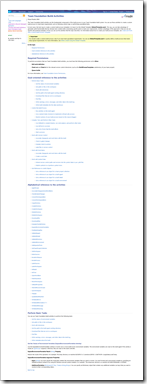Team Foundation Server 2010 Team Build Activity Reference (Think “Oh ,that’s what all those in-the-box Build Activities do” reference)
Andy Lewis - Team Foundation Build Activity Reference is now available
“The Team Foundation Build Default Template enables you to define a build process that can perform the basic tasks you expect from your build system. Use MSBuild to build the bits, run MSTest to test the bits, label the code, publish symbols to SymStore, drop the binaries in a folder, etc. DefaultTemplate.xaml has got you covered; you can get your build process defined and running in a matter of minutes.
But suppose you need your build process to run some custom process against the binaries after building the code. Or to publish some documentation to a web server. My anecdotal experience from monitoring various virtual user groups has left me with the impression is that specialized build processes are the norm rather than the rule.
If you are one of these customers, here is my holiday present to you, hot off the presses:
Team Foundation Build Activities
This article describes in detail the Team Foundation Build Activities, which are the fundamental components of the build process. I wrote this topic with hopes of making it as easy as possible for you to create your own custom build process.
…
Visual Studio Application Lifecycle Management - Creating and Working with Build Definitions - Customizing Team Foundation Build - Team Foundation Build Activities
“The Team Foundation Build activities are the fundamental components of the build process in your Team Foundation Build system. You can use these activities to create a custom build process to meet team requirements such as following custom logic or performing specialized tasks.
In most cases, the best way to create a custom build process template is to base it on the Default Template (DefaultTemplate.xaml). This way, you can take advantage of generally useful functionality that has already been created while customizing specific parts to meet your requirements. Another advantage of this approach is that you can see specific and practical examples of how you can use the activities that this topic describes. For information about how to create your build process template, see Create and Work with a Custom Build Process Template.
Important
You should create a custom build process only if you must meet specialized requirements. You can use DefaultTemplate.xaml to quickly define a build process that meets many typical requirements. For more information, see Define a Build Using the Default Template.
In this topic
…
In my day life we use Team Build (2008) a good bit. While our builds are now where near “far out” we’ve (well Peter) have had to tweak them to fit our needs. So when we one day finally upgrade to TFS 2010/Team Build 2010 (sigh… don’t get me started), with its new build system, may have to again play the build process tweak game.
That’s why this caught my eye. I want to make sure we’re not re-inventing the wheel and understand the existing activities so we can use them to their fullest…






No comments:
Post a Comment